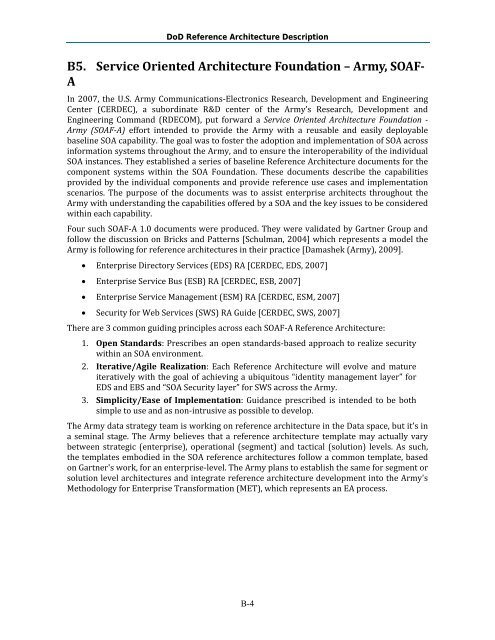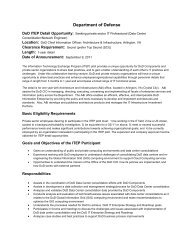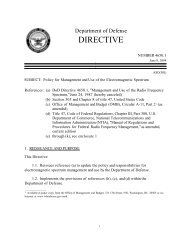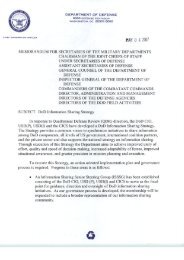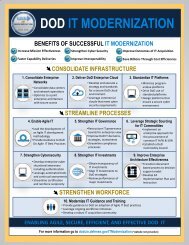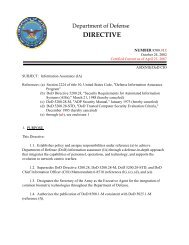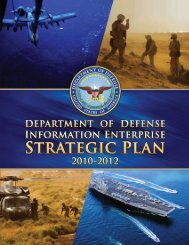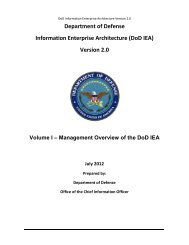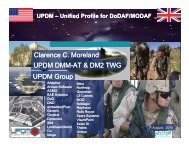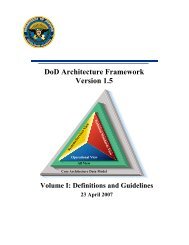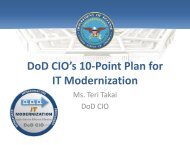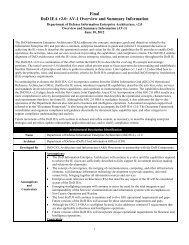Reference Architecture Description - Chief Information Officer
Reference Architecture Description - Chief Information Officer
Reference Architecture Description - Chief Information Officer
You also want an ePaper? Increase the reach of your titles
YUMPU automatically turns print PDFs into web optimized ePapers that Google loves.
DoD <strong>Reference</strong> <strong>Architecture</strong> <strong>Description</strong>B5. Service Oriented <strong>Architecture</strong> Foundation – Army, SOAFAIn 2007, the U.S. Army Communications‐Electronics Research, Development and EngineeringCenter (CERDEC), a subordinate R&D center of the Army’s Research, Development andEngineering Command (RDECOM), put forward a Service Oriented <strong>Architecture</strong> Foundation Army (SOAFA) effort intended to provide the Army with a reusable and easily deployablebaseline SOA capability. The goal was to foster the adoption and implementation of SOA acrossinformation systems throughout the Army, and to ensure the interoperability of the individualSOA instances. They established a series of baseline <strong>Reference</strong> <strong>Architecture</strong> documents for thecomponent systems within the SOA Foundation. These documents describe the capabilitiesprovided by the individual components and provide reference use cases and implementationscenarios. The purpose of the documents was to assist enterprise architects throughout theArmy with understanding the capabilities offered by a SOA and the key issues to be consideredwithin each capability.Four such SOAF‐A 1.0 documents were produced. They were validated by Gartner Group andfollow the discussion on Bricks and Patterns [Schulman, 2004] which represents a model theArmy is following for reference architectures in their practice [Damashek (Army), 2009].• Enterprise Directory Services (EDS) RA [CERDEC, EDS, 2007]• Enterprise Service Bus (ESB) RA [CERDEC, ESB, 2007]• Enterprise Service Management (ESM) RA [CERDEC, ESM, 2007]• Security for Web Services (SWS) RA Guide [CERDEC, SWS, 2007]There are 3 common guiding principles across each SOAF‐A <strong>Reference</strong> <strong>Architecture</strong>:1. Open Standards: Prescribes an open standards‐based approach to realize securitywithin an SOA environment.2. Iterative/Agile Realization: Each <strong>Reference</strong> <strong>Architecture</strong> will evolve and matureiteratively with the goal of achieving a ubiquitous “identity management layer” forEDS and EBS and “SOA Security layer” for SWS across the Army.3. Simplicity/Ease of Implementation: Guidance prescribed is intended to be bothsimple to use and as non‐intrusive as possible to develop.The Army data strategy team is working on reference architecture in the Data space, but it's ina seminal stage. The Army believes that a reference architecture template may actually varybetween strategic (enterprise), operational (segment) and tactical (solution) levels. As such,the templates embodied in the SOA reference architectures follow a common template, basedon Gartner's work, for an enterprise‐level. The Army plans to establish the same for segment orsolution level architectures and integrate reference architecture development into the Army'sMethodology for Enterprise Transformation (MET), which represents an EA process.B-4


